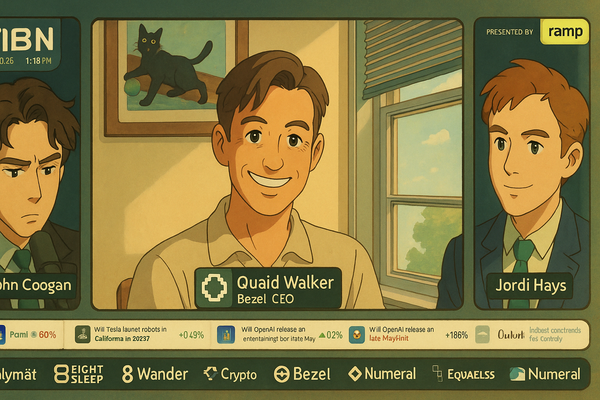Decoding the manosphere
Aggregators upstream, repackagers downstream

Hello from London. I’m hosting a conversation at a dinner with my partners at Outbrain on Wednesday with top publishers and ad buyers to discuss building sustainable news businesses. On Thursday, I’ll be interviewing Metro audience director Sofia Delgago at the Wordpress VIP Innovation Showcase about how Metro grew traffic despite cutting the amount of content it produced.
Today:
- Highlights from our recent video advertising research report
- Decoding the manosphere and a conversation with Stagwell CEO Mark Penn
- AI is coming to the newsroom and to subscriptions too

Engaging a divided country

Now that the election is over, will publishers continue to see engagement from the so-called 'Trump Bump,' or will audiences be more divided over which content resonates versus alienates? While this polarized environment can be challenging, it also offers publishers a unique opportunity to leverage video content to engage audiences who are eager for trustworthy, relevant information. EX.CO’s latest blog post explores how publishers—from news sites to travel and lifestyle brands—can make the most of this period with targeted, balanced video content.
The state of publisher video ad strategies
Tradeoffs are inevitable. We recently released new research, in partnership with EX.CO, to understand how publishers see the tradeoffs between user experience and video ad monetization. We also convened a private dinner in New York last week for publishing leaders to discuss the findings and their approaches to video.
We found that publishers have a mixed view of how well they strike this balance, with no respondents rating their user experience with video as excellent and just 23% rating it good. Most users said it is either fair or needs improvement.
Much of that stems from the mode. While video consumption is exploding, it tends to take place on either connected TVs or dedicated video destinations. The challenge for many text-centric publishers is switching the audience to a different mode. As one attendee put it, "To autoplay or not to autoplay."
The reality of the publishing business means that commercial concerns often trump user experience, our research found. Managing that tradeoff is the key.
Into the manosphere
- On The Rebooting Show, I spoke to Mark Penn, CEO of Stagwell Group and a longtime political operative, about the lessons of the election and how the news industry can chart a sustainable financial future. Listen to The Rebooting Show on Apple | Spotify | other podcast platforms.
- On People vs Algorithms, we covered the rise of the manosphere and the modern art of persuasion. Get PvA on YouTube | Apple | Spotify | other podcast platforms.
In the aftermath of the election, the question the traditional news media faces is one of relevance. Skift’s Rafat Ali has long been vocal that the news industry is obsolete. I wouldn’t go that far. What I would say is it long ago lost its status as information arbiter – the internet made that position untenable – and has lost a surprising amount of ground to a ragtag assortment of Information Space hustlers, from just-asking-questions podcasters to YouTube personalities to Substackers. The transition is becoming clearer:
- Newspapers: AI companies
- Lifestyle magazines: creators
- Cable News: YouTubers, podcasters, Substackers
- Network news: X and Threads
- Cable: streaming services
The endless debates over trust in the news media misses the point of relevance. Debates over New York Times headlines miss the point that many of the issues pushed by the traditional news media did not stick with large numbers of voters. Rogan has become a focal point. He’s undeniably far more powerful that most mainstream media.
The appeal of Rogan and what’s been christened the manosphere is part of a larger realignment within the decentralized information space, where influence is leaking from traditional power centers to fringes. Traditional news media is still powerful. It still breaks most of the news that podcaster and Substackers downstream refine. Modern persuasion is downstream from the newsgathering process. And in that sense, the manosphere is rival to traditional news even if what it does bears no resemblance to what journalists do.
There was a time when late-night comedians filled this downstream role. Many cheered on Jon Stewart in truth-telling mode against a still bow-tied Tucker Carlson.
I wish the LA Times’ billionaire owner much success with that. Elites love the idea of middle-of-the-road politics and media much more than the average person. The traditional news media, as pointed out by Mark Penn in our conversation, is seen as a part of “elite progressivism,” which is a perilous position in a time of populism.
The essential business challenge of news organizations is less how to appeal to both sides. It's being downstream of aggregators at the interface level while value is further leeched downstream in the Information Space.
At the New Growth Agenda last week, where we gathered 50 publishing leaders, a recurring theme was around disintermediation. One exec called news publishers “totally delusional” about the impact of AI answer engines to their businesses and overall relevance.
(The to-be-sure paragraph: This isn’t new. Talk radio was dominated by conservative voices. The original “where is the left’s Joe Rogan” was “where is the left’s Rush Limbaugh.”)
On the latest episode of People vs Algorithms, we discussed the contours of modern persuasion and why the traditional news media is losing at it. The manosphere is filled with male-focused content creators that meld entertainment, self-help, health advice, conspiracy theories, hustle culture, UFC and boxing, and political commentary. There is at least the veneer of open mindedness – UFO curiosity is a central node of the manosphere – not to mention the leverage created by the parasocial relationship these individuals have with their audiences.
The potency of the manosphere was on display this past weekend, both at the UFC in Madison Square Garden, where Trump was greeted as a conquering hero, and with 60 million people watching the stream of the Logan Paul-Mike Tyson spectacle.
The podcast election as theme fell into a “too good to check” category. Its impact appears to be limited although critical in such an evenly divided political landscape.
Still, it’s telling that among the top five most popular election night streams sat one by Patrick Bet-David, a former insurance salesman and host of a macho-tinged podcast that ticks many of the boxes of the manosphere. The topics range far and wide. He had an episode of luxury watches sandwiched between one with Bitcoin hero Michael Saylor and boxing promoter Eddie Hearn. Politics are part of a larger pastiche. It’s no surprise this approach has more impact on “low-information voters” than a “well actually” fact check of RFK Jr’s claims about Fruit Loops.
After all, a common journalist critique of Joe Rogan is that he doesn’t “make news” in his interviews. The hectoring style of 60 Minutes has its place, but I believe much of the appeal of Rogan, Theo Vonn and others is they aren’t obviously try to score points. Rogan is frequently dismissed as an intellectual lightweight, and while I’m not a devoted fan, I’ve found him at least curious.
This is often missing from the traditional news packaging. I’ve long winced at the obsession with fact checks and the know-it-all tone that inevitably backfires when facts turn out to be untrue or at the very least far less cut and dried. The lab leak is only the most handy example. Opinion has long been smuggled into news under the guise of analysis. Much of the “bias” in news media comes with the decisions of what not to cover. Mark mentioned how most of the non-conservative news media downplayed immigration problems and further lost credibility as a result.
There are sensible tactical approaches to all these issues. Better labeling of opinion from news is a start. A focus on government accountability wouldn’t hurt. I expect more news organizations to create partnerships with the indieverse. I’m less sanguine than Mark that the market will reward a broader array of partisan voices. I don’t see evidence that The New York Times, for example, will be rewarded in the market for adding MAGA columnists.
The AI opportunity
AI dominated much of the discussion at the New Growth Agenda. Much of the attention focused on AI and search, of course, but there was increased emphasis on embedding AI within internal processes. My early 2025 prediction is it will be the year when publishers adopt AI throughout their businesses. We recently held a pair of Online Forums on two aspects of AI in publishers:
- AI in the Newsroom examined how newsrooms are using AI to streamline mundane tasks in the editorial workflow. Nota CEO Josh Brandau joined me in this discussion of best practices for adopting assistive AI for efficiency gains. View the replay. (Thanks to Nota for sponsoring)
- AI and Personalization to Drive Subscription Growth featured a discussion I had with Zuora senior product manager Jonathan Harris about how AI figures prominently in the future of subscriptions as when to block people and the offers to put in front of them gets handed over to AI. Fun fact from preparation for this session: The New York Times debuted its metered paywall in March 2011 with a limit of 20 free articles. Times have changed. View the replay. (Thanks to Zuora for sponsoring)
Thanks for reading. Send me a note with feedback by hitting reply.




